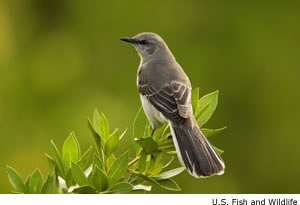
One year for Christmas, back when I was married, my husband bought me a bird book when he couldn't think of anything else to get for me. It was a gift born of desperation, and it was probably the best and most lasting gift he ever gave me (my kids don't count for this, because they were a gift from God).
I spent hours flipping through the glossy photos, looking at birds I'd never seen or heard of. The black-crowned night heron was scrunched and looking off to the side, and it looked like the profile of Alfred Hitchcock from his old TV show. The red-breasted merganser was obviously the inspiration behind Daffy Duck, with the feathers sticking out the back of his head in wild abandon. And the black-necked stilt is probably one of the happiest-looking birds.
It's hard to identify some of the birds I see, because they won't stay still long enough. But others cooperate just fine. I've had the book long enough that it fell apart and I've had to replace it. And I've gone from knowing almost nothing about birds ("Looks like some kind of hawk") to knowing that was an osprey I saw yesterday morning on my way to work as it perched on a power line above an overgrown creek bed.
It's not that I sat down and tried hard to learn the birds, but more that I just looked through the book about a million times and picked it all up through osmosis.
So when I was in Texas last weekend, I saw some of these guys in the picture at the top of this post (I couldn't get my pictures to upload right, so I borrowed one that looked like mine). When I saw the white flashes of the wings and tail when they flew, I thought, "Mockingbird." But then they started making noise, and I began to doubt myself.
Around my house the mockingbirds sound something like this: "Tweet tweet tweet, CHIRPee, CHIRPee, CHIRPee, tweedle tweedle, cheep cheep cheep." In Texas, they just squawked like small versions of ravens--nothing musical at all. So I asked a docent at the park I was visiting what those birds were, and she said that they really were mockingbirds, which restored my sense of sanity but left me pitying Texans who don't get a true seranade in the morning.
It amazes me sometimes that an afterthought of a gift like my bird book opened up a whole world that I had never noticed before. Now I inhabit a planet filled with wood ducks and mandarin ducks and western meadowlarks (but meadowlarks are another story), and they make it a planet filled with delight.
I recommend the bird book. Get the red one if you live in the West, and get the green one if you live in the East. Don't get a book with drawings--you'll want the glossy photos. Open up a new world for yourself that's for the birds.
3 comments:
I went to college in upper east Tennessee... and while there I took a course in "Field Biology." The professor, Dr Wallace, was an ornithologist and all he ever wanted to do was go "Birding." He had a freezer full of dead birds in plastic bags... could do all sorts of bird whistles and calls, and had recordings of the ones he couldn't mimick. It was fun.
My favorite bird, which was plentiful in the mountains, and one you rarely see in Indiana, is the Indigo Bunting. It's just the bluist thing you've ever seen. I don't know if its range extends to California, but if you've seen one you won't forget it.
I've often wondered... if the Starling, which has disgustingly overpopulated our area, hadn't been introduced from Europe, would Indiana's bird population be more interesting?
The biggest development in this area is the return of the hawks. The DDT must finally be dissipating because I now see birds that I never saw when I was a kid. Dad has even seen a bald eagle while fishing on the Missisinewa. Amazing.
Chris,
"He had a freezer full of dead birds in plastic bags..." Oh, that image is too funny.
When your dad saw the bald eagle, did the eagle try to steal your dad's fish?
One October, long ago (I think it was in the 1980s), I went to Glacier National Park, and they had a Mr. Ranger Sir who knew all about bald eagles. He would go from one National Park to another, giving lectures on the eagles and setting up spotting scopes for the general public to look through. He said that bald eagles would rather steal fish from each other than go to the water and catch their own.
So we watched the bald eagles there during salmon spawning season. They would go through Glacier to get back to Whitefish Lake in Montana to spawn.
They don't do that anymore, because somebody introduced fresh-water shrimp to Whitefish Lake. The shrimp came between the salmon and their normal food, so now there aren't any salmon in Whitefish Lake, which means there aren't any eagles following them through Glacier NP to get back to Whitefish Lake.
Kind of like the starlings. You have no idea what's missing unless you saw it before the introduction.
You might need to visit Dr. Wallace's freezer once in a while to see some other birds...
Charlie,
Do you get a variety of hummingbirds? In my area we only get Anna's Hummingbird, but they're beautiful, so I don't mind at all. They have the nicest song, a tiny chit chit chit, but it took a long time for me to figure out that the hummingbirds were making that noise.
Post a Comment